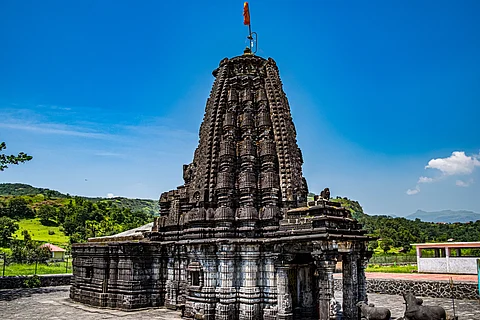
- Destinations
- Experiences
- Stay
- What's new
- Celebrating People
- Responsible Tourism
- CampaignsCampaigns
- Subscribe
- Buy Now

Maharashtra is home to several temples in offbeat and remote places that are known for their tranquil atmosphere. These temples provide a unique combination of serene spirituality and architectural beauty, often in more secluded areas than the more commonly visited locations. For those who seek spirituality amid peace, they are great destinations to visit. Here is a look at eight peaceful temples in offbeat parts of Maharashtra.
Situated at the foothills of Purandar fort in Narayanpur, near Saswad, the Changa Vateshwar Temple showcases Hemadpanti architecture with its intricate stonework and robust design. It has been built with locally mined black basalt stone, with elaborate murals and sculptures depicting Hindu deities and mythological scenes. The temple is also known for its unique combination of deities worshipped, including Nilamadhava (Vishnu) and Siddeshwar (Shiva).
The Pateshwar Shiva Temple, located near Satara, is special for its ancient cave complex. It is believed to be at least 500 years old and features eight ancient stone caves, including one housing the Maha Shiva Lingam with beautiful carvings. The temple also boasts over 1,000 Shivalingas, various other deities, and a serene atmosphere in a lush green area.
Though located in the heart of Kasba Peth, the oldest part of Pune city, this temple has a peaceful atmosphere. The temple dates back to 1868 and was rediscovered in an excavation, highlighting its rich history. It was an ancient Shiva temple and it features the characteristic Hemadpanthi architectural style, which is known for its intricate carvings and design. The temple spire has carvings of snakes and the symbol of Om, which are significant in Hindu symbolism.
Located in a remote hillock about 2.5 km from the village of Mahur, the centuries-old Renuka Devi Temple is one of the hidden spiritual gems of Maharashtra. Among the things to watch out for are the intricately carved stone walls, grand pillars, and gold ornaments, including golden flowers and garlands, contributing to its grandeur. But it is not just the architectural details that would draw you in; the temple is also a revered Shakti Peetha. This sacred shrine marks the spot where the head of Goddess Renuka fell after her son, Parashurama, decapitated her.
Located about 70 km from Kolhapur city on the border of Karnataka, the temple is Situated in the small village of Khidrapur, on the banks of the Krishna River. The temple's Swarg Mandap is round and supported by 48 well-carved stone pillars. It's an open-sky structure, creating a unique visual experience. The stunning carvings of deities, mythological figures, and even everyday scenes are worth noting. These carvings are highly detailed and depict various aspects of Hindu mythology and cultural elements. The temple also features a unique elephant panel and intricate carvings of deities and secular figures. Unlike most Shiva temples, the Kopeshwar Temple does not have a Nandi (bull) at its entrance. The temple is built with basalt stone, allowing for intricate carvings and long-lasting durability.
The Kedareshwar Cave Temple is a Shiva temple located in the Harishchandragad Fort, a hill fort in the Ahmednagar district of Maharashtra. The temple is nestled within a naturally formed cave, a unique and awe-inspiring feature. A prominent Shiva Lingam, believed to be self-manifested, is the central focus of the temple, located within the cave and surrounded by water. A mythological legend says the remaining pillar of the temple is believed to symbolise the current age, and its collapse would mark the end of the world. It is the temple's location in a mountainous setting that adds to its charm.
The temple dates back to the early 17th century, and is carved from wood and basalt rock. You would be hard-pressed to find a more beautiful location than this. Dedicated to Lord Shiva, the Dhutpapeshwar Temple is situated on the banks of the Mrudani River. The serene atmosphere. with the surrounding mountains and a waterfall will draw you in.
The Amruteshwar Temple in Bhandardara is nestled in a natural environment, surrounded by forests and rivers, offering a peaceful and serene atmosphere. It is a significant, ancient Shiva temple known for its intricate carvings and some unique features like the hot spring below the Shiv Lingam. Built over 1,200 years ago by the Shilahara dynasty, it follows the Hemadpanthi style of architecture, common in Maharashtra. The temple features a Nandi mandap with a small shikhara and an underground garbhagriha (sanctum sanctorum) with carved pillars.
